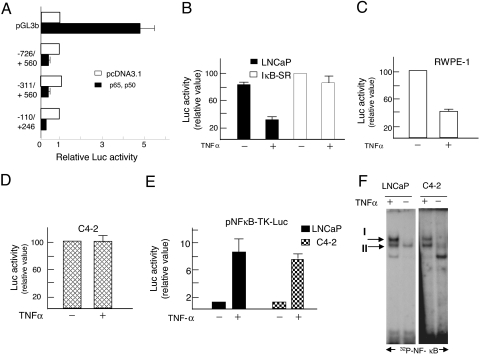Figure 4.
AR Promoter Repression by NF-κB-p65/p50 in Androgen-Dependent LNCaP and RWPE-1 Prostate Cells and Lack of the Repression in Androgen-Independent C4-2 Cells
A, Luciferase reporter activity is shown for each construct in p65 and p50 cotransfected LNCaP cells relative to pcDNA3.1-transfected cells. Reporter expression was directed by the human AR promoters (−110/+246, −311/+560, −726/+560) or from the pGL3b vector itself. Data are averages with sd from three independent transfections. B, Repression of the −110 to +246 AR promoter by TNFα in LNCaP cells, and lack of the negative regulation in the presence of IκB-SR. The AR promoter-reporter was transfected into LNCaP (solid bar) or LNCaP-SR-IκB cells (open bars), and 24 h later the cells were treated with vehicle or TNFα (20 ng/ml) for an additional 24 h before the cells were analyzed for luciferase. Luciferase values are presented relative to the 100% value set for LNCaP-IκB-SR cells in the absence of TNFα. C, Repression of the AR promoter (−110 to +246) in RWPE-1 (AR-positive, nontumorigenic) cells treated with TNFα. Transfection conditions were same as in panel B. D, Absence of the TNFα effect on the AR promoter (−110 to +246) in C4-2 cells. It should be noted that the luciferase values were comparable in LNCaP and C4-2 cells in the absence of TNFα treatment. In contrast to LNCaP cells, C4-2 cells showed no reduction of luciferase activity after TNFα treatment. E, Comparable NF-κB activation by TNFα in LNCaP and C4-2 cells. Transactivation of a canonical NF-κB element was assayed in transfected LNCaP and C4-2 cells with or without TNFα treatment. F, NF-κB DNA-binding activity in TNFα-treated LNCaP and C4-2 cells. The NF-κB element from the IL-6 gene was used as the EMSA probe. TNFα treatments in panels B–F were for 24 h at 20 ng/ml.

